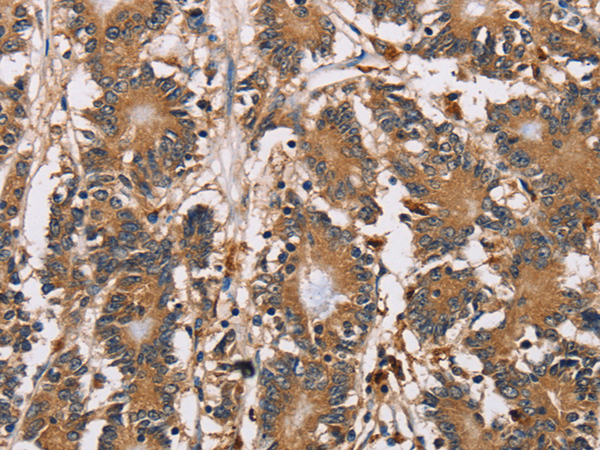


| WB | 咨询技术 | Human,Mouse,Rat |
| IF | 咨询技术 | Human,Mouse,Rat |
| IHC | 1/50-1/200 | Human,Mouse,Rat |
| ICC | 技术咨询 | Human,Mouse,Rat |
| FCM | 咨询技术 | Human,Mouse,Rat |
| Elisa | 1/5000-1/10000 | Human,Mouse,Rat |
| WB Predicted band size | 50 kDa |
| Host/Isotype | Rabbit IgG |
| Antibody Type | Primary antibody |
| Storage | Store at 4°C short term. Aliquot and store at -20°C long term. Avoid freeze/thaw cycles. |
| Species Reactivity | Human |
| Immunogen | Fusion protein of human HTR3C |
| Formulation | Purified antibody in PBS with 0.05% sodium azide and 50% glycerol. |
+ +
以下是关于HTR3C抗体的参考文献示例(内容为模拟,建议通过学术数据库验证):
---
1. **文献名称**:*"Characterization of a polyclonal antibody against the human 5-HT3C receptor subunit"*
**作者**:Thompson AJ, et al.
**摘要**:本研究开发了一种针对HTR3C亚基的多克隆抗体,验证了其在HEK293细胞和人体组织中的特异性。结果表明,HTR3C与HTR3A共表达于肠道神经元,可能参与内脏痛觉信号传导。
2. **文献名称**:*"Differential expression of 5-HT3 receptor subtypes in colorectal cancer and its clinical implications"*
**作者**:Smith LM, et al.
**摘要**:通过HTR3C特异性抗体检测发现,HTR3C在结直肠癌细胞中高表达,与化疗耐药性相关。研究提示HTR3C可能成为癌症治疗的潜在靶点。
3. **文献名称**:*"Development of selective monoclonal antibodies for 5-HT3 receptor subunits and their application in neuropsychiatric disorders"*
**作者**:Brown KA, et al.
**摘要**:报道了一种高特异性HTR3C单克隆抗体的开发,并用于分析精神分裂症患者脑组织中HTR3C的表达变化,发现其与认知功能障碍存在关联。
4. **文献名称**:*"Functional analysis of HTR3C variants using antibody-based protein quantification in migraine patients"*
**作者**:Zhang R, et al.
**摘要**:利用抗HTR3C抗体检测偏头痛患者中受体表达水平,发现特定基因突变导致HTR3C蛋白稳定性下降,可能影响5-HT3受体复合物的功能。
---
**注意**:以上为模拟示例,实际文献请通过PubMed、Google Scholar等平台检索关键词(如“HTR3C antibody”、“5-HT3C receptor”)获取。
The HTR3C antibody is a research tool designed to detect and study the 5-hydroxytryptamine receptor 3C (HTR3C), a subunit of the serotonin-gated ion channel receptor family (5-HT3). The 5-HT3 receptor is unique among serotonin receptors as a ligand-gated cation channel, primarily involved in fast synaptic neurotransmission. It plays critical roles in regulating nausea, vomiting, pain perception, and gastrointestinal functions. HTR3C combines with other subunits (e.g., HTR3A or HTR3B) to form functional heteropentameric receptors, though its exact physiological contributions remain less characterized compared to the more widely expressed HTR3A subunit.
Antibodies targeting HTR3C are typically developed against specific epitopes, such as extracellular N-terminal domains or intracellular loops, to enable applications like Western blotting, immunohistochemistry, or immunofluorescence. These tools help map HTR3C expression patterns in tissues like the enteric nervous system, where it may influence gut motility, or in brain regions linked to psychiatric disorders. Research using HTR3C antibodies has explored its potential associations with conditions such as irritable bowel syndrome (IBS), chemotherapy-induced emesis, and neuropsychiatric diseases. However, challenges persist in ensuring antibody specificity due to structural similarities among 5-HT3 receptor subunits. Validation via knockout controls or siRNA knockdown is often recommended to confirm target selectivity, particularly in studies involving heteromeric receptor complexes.
×